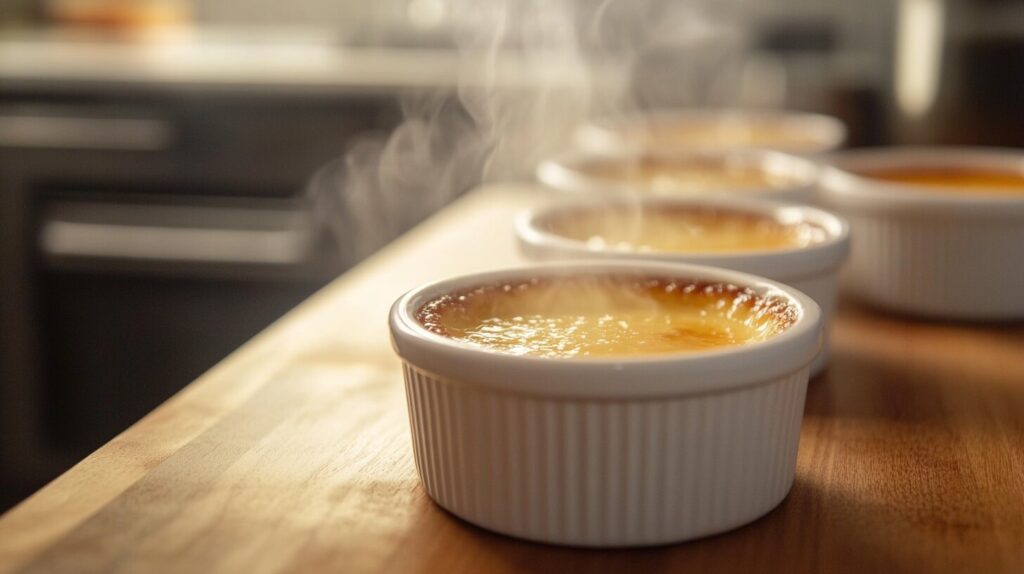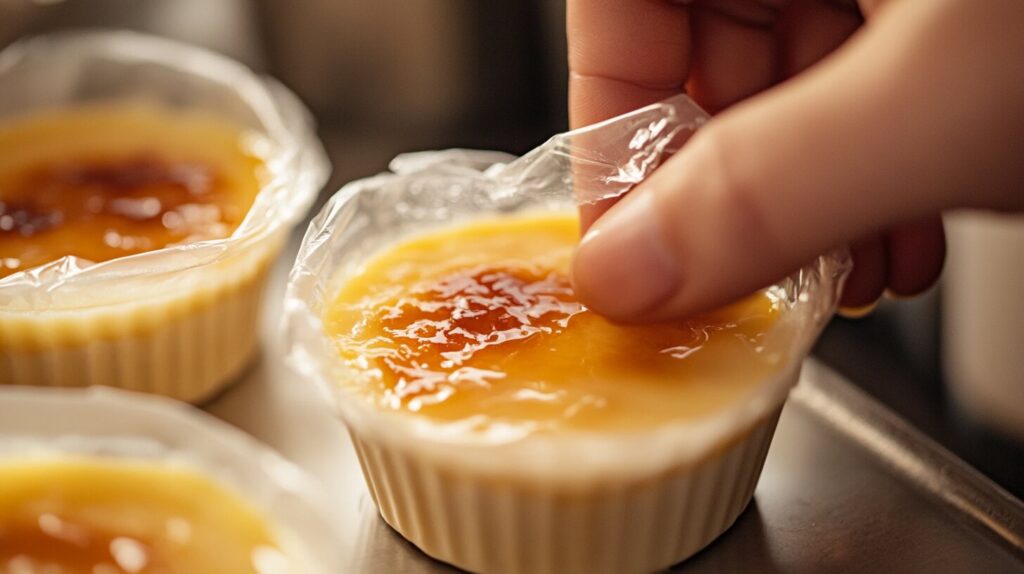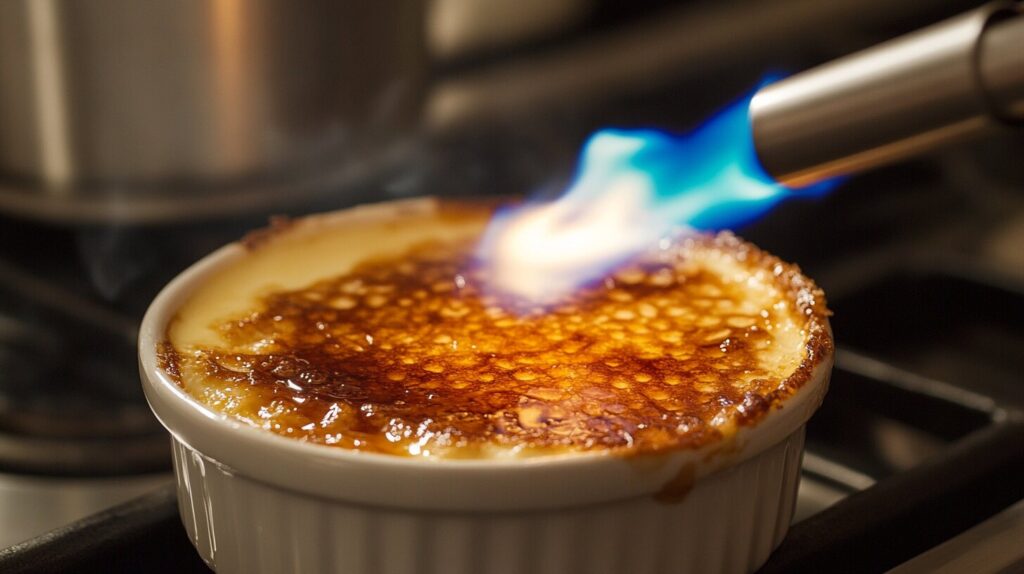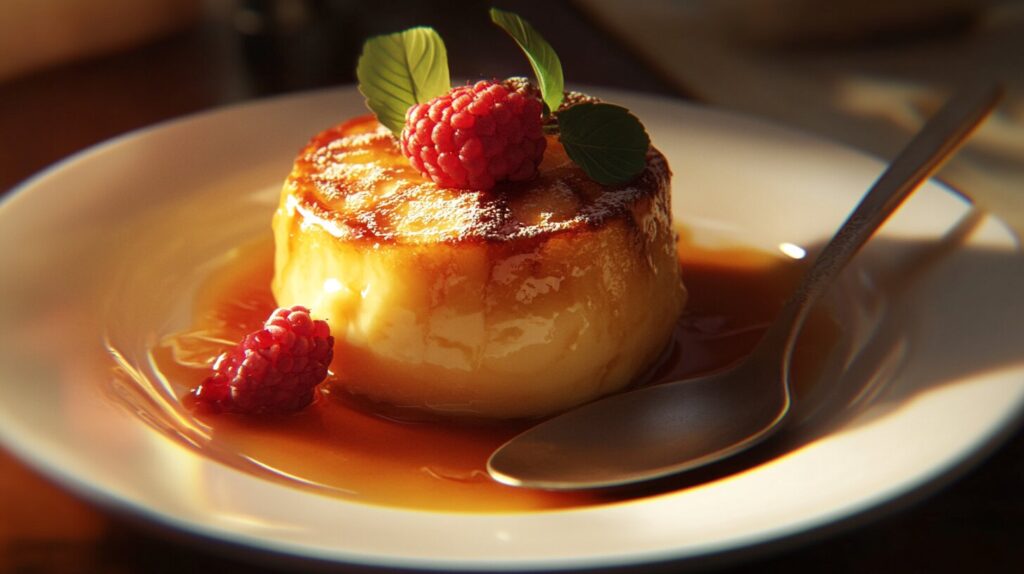There’s nothing quite like the creamy, luxurious taste of cooked crème brûlée. It’s a classic dessert that’s both simple and sophisticated, with a velvety custard base and a crackling caramelized sugar top. But what if you have leftovers or want to prepare it ahead of time? Storing cooked crème brûlée properly is essential to preserving its signature texture and flavor. The last thing you want is for your crème brûlée to lose its magic during storage.
In this guide, you’ll learn everything there is to know about storing cooked crème brûlée properly — from ideal temperatures to storage containers and even solutions to common storage mishaps. Let’s make sure your crème brûlée stays as delightful as the moment you made it! 🥄
Table of Contents
Why Properly Storing Cooked Crème Brûlée Matters
When it comes to crème brûlée, storage is not just a matter of convenience; it’s about preserving that perfect balance of creamy custard and crisp sugar topping. Improper storage can turn your decadent dessert into a disappointing mess.
Why does it matter so much? Well, the custard base is delicate and can easily curdle, dry out, or absorb unwanted fridge odors. Likewise, the caramelized sugar topping can become soggy or lose its crunch if not handled correctly. You worked hard to create that masterpiece, so it’s worth taking a few extra steps to keep it just right!
🍮 “Great desserts are not just about taste, but about texture and experience. Crème brûlée deserves a little extra care to stay spectacular!”
The Ideal Temperature for Storing Cooked Crème Brûlée
Temperature plays a crucial role in maintaining the integrity of crème brûlée. After cooking, crème brûlée needs to be stored in the fridge — but not just anywhere or at any temperature.
- Ideal Fridge Temperature: The best temperature for storing cooked crème brûlée is around 36°F to 40°F (2°C to 4°C). This range keeps the custard firm without freezing it.
- Avoid Freezer Burn: The freezer might seem like a good long-term solution, but freezing can alter the texture of the custard (more on that later).
Storing crème brûlée too cold can lead to ice crystals forming in the custard, making it grainy. Too warm, and the custard may not set properly or could spoil quickly.
Pro Tip: If your fridge has a “sweet spot,” where items don’t get too cold or too warm, store your crème brûlée there. The middle shelves usually maintain the most consistent temperature. ❄️
How to Prepare Crème Brûlée for Storage After Cooking
Storing cooked crème brûlée isn’t just about popping it into the fridge and calling it a day. You need to prepare it correctly to keep it fresh.
Cooling Crème Brûlée Before Storage

After baking, your crème brûlée needs to cool properly before being stored. Here’s how to do it:
- Room Temperature Cooling: Allow your crème brûlée to cool at room temperature for about 30 to 45 minutes.
- Refrigeration: Once it reaches room temperature, place the ramekins in the fridge uncovered. Let them chill for at least 2 hours so the custard sets fully.
Why does this matter? Cooling the custard gradually helps prevent condensation, which could ruin the smooth texture of your dessert.
Covering Your Crème Brûlée for Optimal Freshness

Once the crème brûlée has cooled completely, it’s time to cover it:
- Plastic Wrap: Gently cover each ramekin with plastic wrap, making sure the wrap doesn’t touch the surface of the custard. This prevents moisture and fridge odors from seeping in.
- Aluminum Foil: If you prefer, you can use aluminum foil. It provides a bit more protection but can also trap moisture if not sealed properly.
Quick Tip: Poke a few tiny holes in the plastic wrap if you’re worried about condensation.
🌟 “A well-wrapped crème brûlée is like a gift waiting to be opened — keep it fresh to enjoy it at its best!”
Best Containers for Storing Cooked Crème Brûlée
The container you choose for storing crème brûlée is just as important as the cooling process. Picking the right vessel ensures your dessert stays pristine.
Glass Ramekins vs. Plastic Containers
- Glass Ramekins: These are the gold standard for crème brûlée. They are oven-safe, easy to clean, and don’t retain odors. Plus, they look elegant!
- Plastic Containers: While convenient, plastic containers can sometimes transfer flavors or absorb odors. If you use plastic, make sure it’s BPA-free and airtight.
Sealing Options to Keep Crème Brûlée Fresh
Sealing is crucial for keeping your crème brûlée fresh. Here are some great sealing options:
- Airtight Lids: If your ramekins come with airtight lids, use them! They help maintain freshness and prevent odors.
- Double Sealing: For extra protection, wrap the ramekin with plastic wrap and cover with a lid or foil.
Pro Tip: Label your containers with the date so you know how long they’ve been stored. Freshness is key! 🗓️
How Long Can Cooked Crème Brûlée Be Stored in the Fridge?
Crème brûlée is best enjoyed fresh, but if you need to store it, here’s what you need to know:
- In the Fridge: Cooked crème brûlée can be stored in the fridge for up to 3 days. Beyond that, the texture might start to degrade.
- Signs It’s Time to Toss It: If the custard appears watery, the sugar topping is soft, or there’s an off smell, it’s better to say goodbye.
Want it to last longer? Freeze it! But proceed with caution — freezing crème brûlée requires a careful touch (and we’ll get to that shortly).
Can You Freeze Cooked Crème Brûlée? Tips and Techniques
Freezing crème brûlée can be a lifesaver if you want to prepare dessert in advance. But it does come with its risks and rewards.
Pros and Cons of Freezing Crème Brûlée
Pros:
- Convenience: Make ahead and store for special occasions.
- Less Waste: Freeze leftovers instead of tossing them.
Cons:
- Texture Changes: Freezing can alter the custard’s creamy texture.
- Topping Issues: The sugar top won’t stay crisp after freezing.
Step-by-Step Guide to Freezing Crème Brûlée Correctly
- Don’t Torch the Sugar: If you know you’ll freeze it, skip caramelizing the sugar until after thawing.
- Wrap Well: Let the custard cool, then wrap each ramekin tightly with plastic wrap and aluminum foil.
- Store Flat: Place ramekins in a single layer to prevent spills.
- Freeze for Up to 1 Month: Any longer, and the texture might suffer.
- Thawing: Thaw in the fridge overnight. Add the sugar topping and torch before serving for that signature crunch!
🔥 “Frozen doesn’t mean forgotten. Thaw carefully, and your crème brûlée will shine again!”
How to Reheat Cooked Crème Brûlée Without Compromising Texture
Reheating crème brûlée can be a tricky process. While the custard itself doesn’t usually require reheating, sometimes you may need to reheat to achieve that perfect, crisp sugar topping. So, how can you do this without compromising the texture of your delicate dessert? Let’s break it down step by step!
Reheating Crème Brûlée in an Oven
If your crème brûlée has been stored in the fridge or thawed from the freezer, reheating it in the oven can gently warm it up without affecting the custard’s smooth texture. Here’s how you can do it:
- Preheat the Oven: Set your oven to 300°F (150°C). This low temperature prevents the custard from curdling.
- Cover the Ramekins: Place the ramekins on a baking tray and cover them loosely with aluminum foil to avoid direct heat.
- Warm for 10-15 Minutes: Heat the crème brûlée gently for about 10-15 minutes. Be careful not to overheat; you’re just aiming to take the chill off the custard.
- Cool Before Caramelizing: Let the custard cool to room temperature before adding and torching the sugar topping.
Why this works: Slow, gentle reheating helps maintain the velvety texture of the custard while preventing the edges from overcooking.
Using a Kitchen Torch for Reheating the Sugar Top

Ah, the kitchen torch — the crème brûlée’s best friend! When it comes to reheating or creating that signature crackly sugar top, a torch is the most effective tool. Here’s how to do it right:
- Sprinkle Fresh Sugar: After your crème brûlée has been gently reheated or thawed, add a fresh layer of granulated sugar (about 1-2 teaspoons per ramekin).
- Torch Evenly: Hold the torch about 2-3 inches above the sugar. Move the flame in a circular motion to evenly melt and caramelize the sugar.
- Watch for Color Changes: The sugar will bubble and turn golden brown. Be patient and avoid burning the sugar.
- Cool for 1-2 Minutes: Let the sugar harden for a minute or two before serving to get that satisfying crack.
🔥 “A perfect crème brûlée is like a magic trick — torch the sugar, let it cool, and watch the magic happen!”
Pro Tip: If you don’t have a kitchen torch, you can use the broiler setting in your oven. Just place the ramekins under the broiler for 1-2 minutes, keeping a close eye to prevent burning.
Common Problems with Storing Cooked Crème Brûlée and How to Fix Them
Even the best-laid plans can go awry, especially with delicate desserts like crème brûlée. Here are some common storage issues and how to fix them.
Avoiding Soggy Sugar Topping During Storage
A soggy sugar topping can ruin the classic crème brûlée experience. The problem? Moisture from the fridge softens the caramelized sugar.
Solution:
- Don’t Caramelize in Advance: Store the custard without the sugar topping. Only caramelize the sugar right before serving.
- Re-Torch the Topping: If the topping gets soggy, simply add a fresh layer of sugar and torch it again to revive that crisp texture.
Preventing the Custard from Curdling or Splitting
Curdled custard can be a real disappointment. This happens when the custard is overcooked, reheated too quickly, or exposed to drastic temperature changes.
Solution:
- Cool Gradually: Let the custard cool slowly to avoid temperature shock.
- Gentle Reheating: Use a low oven temperature when reheating to avoid overheating.
- Check Your Recipe: Ensure you’re not over-baking during the initial preparation.
Dealing with Condensation on the Custard
Condensation forms when warm custard is placed in a cold fridge, causing moisture to accumulate.
Solution:
- Cool First: Always let the crème brûlée cool to room temperature before refrigerating.
- Loose Wrapping: Cover the ramekin loosely with plastic wrap or foil to allow airflow while keeping odors out.
💡 “Remember, crème brûlée is all about patience. Treat it gently, and it’ll reward you with perfection!”
How to Maintain the Signature Texture of Crème Brûlée After Storage
The hallmark of a great crème brûlée is the contrast between its silky custard and crunchy sugar topping. After storing, it can be challenging to maintain that perfect texture. Here’s how to keep your crème brûlée as flawless as the moment it was made.
Ensuring a Smooth, Creamy Custard
- Avoid Freezer Burn: If freezing, double-wrap your crème brûlée to prevent ice crystals from forming.
- Reheat Gently: When thawing or reheating, always use low temperatures to avoid disrupting the custard’s delicate structure.
Achieving a Perfectly Crisp Sugar Topping Post-Storage
- Fresh Sugar Layer: Before serving, sprinkle a fresh layer of sugar and torch it to perfection.
- Serve Immediately: The sugar topping is best enjoyed right after caramelizing to preserve that signature crunch.
🍯 “Crème brûlée’s beauty lies in its simplicity — a little care goes a long way to keep it perfect!”
How to Tell if Stored Crème Brûlée Has Gone Bad
Knowing when to toss your stored crème brûlée can save you from a culinary disaster. Here are some signs that it’s time to say goodbye:
Signs of Spoiled Crème Brûlée: What to Watch For
- Watery Texture: If the custard releases a lot of liquid, it’s likely spoiled.
- Off Smell: A sour or off-putting smell is a clear indicator it’s gone bad.
- Mold Spots: If you see any mold, discard the entire dessert.
- Odd Taste: When in doubt, take a small taste. If it doesn’t taste right, don’t risk it.
General Rule: If your crème brûlée has been in the fridge for more than 3 days, or in the freezer for more than a month, it’s safer to let it go.
Storing Leftover Crème Brûlée Ingredients for Future Use
Sometimes, you might end up with leftover ingredients after making crème brûlée. Here’s how to store them for future dessert adventures!
Keeping Egg Yolks Fresh for Later Recipes
- In the Fridge: Store egg yolks in an airtight container with a bit of water to keep them moist. Use within 2 days.
- In the Freezer: You can freeze egg yolks, but beat them with a pinch of salt or sugar to prevent them from becoming gelatinous.
Preserving Heavy Cream for Extended Shelf Life
- In the Fridge: Keep heavy cream in its original container, tightly sealed, for up to 1 week past its sell-by date.
- In the Freezer: Freeze heavy cream in portions, but remember to thaw it in the fridge and shake well before using.
🥚 “Leftover ingredients are just another opportunity to make something delicious!”
Final Tips for Perfectly Storing Cooked Crème Brûlée
You’ve now learned the ins and outs of storing your cooked crème brûlée — from proper cooling methods to ideal containers and reheating techniques. But let’s wrap up with some final, golden tips to make sure your dessert stays as perfect as the day you made it.
Plan Ahead for the Best Results
If you know in advance that you’ll need to store your crème brûlée, planning ahead can make all the difference. Here are a few pointers:
- Make in Advance: Prepare the custard base a day ahead but leave the caramelized sugar topping until just before serving. This ensures the topping remains crisp and fresh.
- Batch Storage: If you’re serving multiple guests, prepare several small ramekins and store them individually. This way, you only reheat what you need without disturbing the others.
Avoid Drastic Temperature Changes
Crème brûlée doesn’t like surprises — especially when it comes to temperature. Avoid exposing it to drastic changes that can damage its delicate texture.
- Gradual Cooling: Always allow your dessert to cool to room temperature before refrigerating.
- Thaw Slowly: If you’ve frozen crème brûlée, always thaw it in the fridge overnight rather than at room temperature to prevent condensation and maintain texture.
🌡️ “Treat your crème brûlée like a VIP — slow transitions and gentle handling will keep it at its best!”
Keep It Simple with Ingredients
Sometimes, the key to great crème brûlée storage is in the simplicity of your recipe. Stick to high-quality ingredients and avoid unnecessary additions that might complicate storage.
- Fresh Cream and Eggs: Use the freshest cream and eggs you can find to ensure longevity.
- Minimal Flavorings: If you love adding flavors (like vanilla bean or citrus zest), keep them subtle. Overpowering flavors might change after refrigeration or freezing.
Frequently Asked Questions About Storing Cooked Crème Brûlée
How long can crème brûlée last in the fridge?
Cooked crème brûlée can be stored in the fridge for up to 3 days. After that, the texture and flavor may begin to degrade.
Can I freeze crème brûlée with the sugar topping already caramelized?
It’s best not to freeze crème brûlée with the sugar topping already caramelized. The sugar will lose its crunch and become soggy during thawing. Instead, freeze the custard base and caramelize the sugar just before serving.
What’s the best way to thaw frozen crème brûlée?
Thaw frozen crème brûlée in the fridge overnight for the best results. This slow thawing process helps maintain the custard’s creamy texture.
How do I stop condensation from ruining my crème brûlée?
To avoid condensation, make sure the custard is cooled to room temperature before covering and refrigerating. When wrapping, use plastic wrap or foil loosely to allow some airflow.
Can I reheat crème brûlée in the microwave?
Reheating crème brûlée in the microwave is not recommended, as it can cause the custard to overcook or curdle. Stick to reheating in a low-temperature oven for the best results.
Is it possible to fix a soggy sugar topping?
Yes! If your sugar topping has turned soggy, sprinkle a fresh layer of sugar on top and use a kitchen torch to re-caramelize it. This will restore the crisp, crackly texture.
Bringing It All Together: Enjoy Your Perfect Crème Brûlée Anytime

Storing cooked crème brûlée may seem like a daunting task at first, but with the right approach, it’s completely manageable. Whether you’re making it ahead for a special occasion or saving leftovers to enjoy later, a little care and attention go a long way in keeping this classic dessert perfect.
Remember, crème brûlée is all about balance — the creamy custard and the brittle sugar topping. With the tips and techniques you’ve learned, you can confidently store, freeze, and reheat your crème brûlée without losing any of that magic.
🍮 “Every spoonful of crème brûlée should feel like a celebration. With the right storage, you can savor that celebration anytime!”
Explore More Delicious Tips and Recipes
If you enjoyed learning about storing crème brûlée, there’s even more to explore! From other dessert storage tips to step-by-step recipes, check out these helpful guides:
- Discover the best ways to serve and enjoy crème brûlée with our guide on How Should Crème Brûlée Be Served?
- Need a perfect dessert recipe for your next dinner party? Try our Mastering French Pastry Recipes: A Complete Guide
- No kitchen torch? No problem! Find out What Can I Use If I Don’t Have a Crème Brûlée Torch?
- For a creative twist on classic flavors, indulge in our unique Crab Brûlée Recipe
Keep exploring and keep your desserts delightful! 🍮✨
